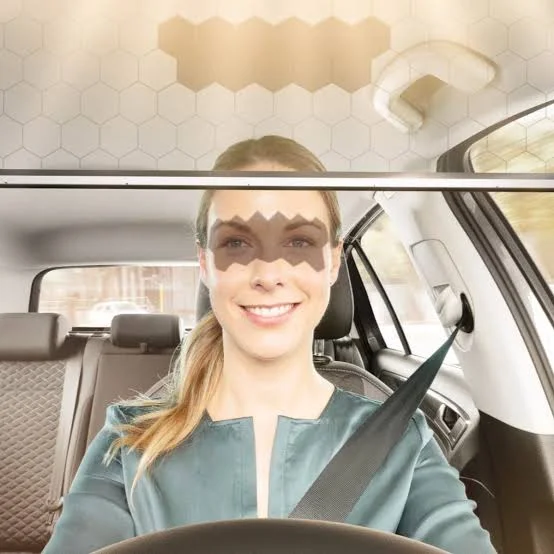Here's a stat that might floor you: NHTSA data shows sun glare causes nearly twice as many accidents as any other weather phenomenon. Yet most drivers think that little mirror tucked behind their sun visor is there for one reason and one reason only, touch ups and lipstick checks.
Wrong‼️
That compact reflective surface has a backstory rooted in automotive innovation, dealer profit margins, and practical safety needs that have nothing to do with vanity. While your passengers might joke "I know I look good already" when they flip down that mirror, the truth is far more intriguing than most automotive professionals realize.
The Accidental Beginning of Interior Mirrors
Back in 1924, an amateur inventor named Hathaway created what he called a "glare shield" for Ford Model T vehicles. This external visor was Ford's answer to a growing problem: drivers getting blinded by sun glare in their enclosed vehicles. The concept caught on quickly.
By 1931, these visors moved inside the vehicle as automotive design evolved. Interior mounting made the hinged flap easier to reach and adjust, setting the stage for what would become a lucrative dealer accessory market.
But here's where it gets interesting! Those early visors were purely functional. No mirrors, no vanity features.
The Profit Motive Behind Your Mirror
For decades, visor mounted mirrors became among the most popular dealer added accessories that provided high profit margins, with sales staff receiving extra incentives to sell them. Think about that. Your seemingly simple mirror wasn't originally a standard feature. It was an expensive add-on that dealerships pushed because it was essentially printing money.
"My car came with everything I need," customers would say. Then dealers would demonstrate the convenience of having a mirror right there in the visor. Sales magic.
These weren't complex installations either. The mirrors were simple, profitable upgrades that transformed a basic sun shield into a multi functional accessory. Dealerships loved them because installation was quick, customer satisfaction was high, and margins were substantial.
The Real Safety Applications
Modern automotive professionals understand that visor mirrors serve several critical functions beyond cosmetic touch-ups:
- Passenger Monitoring: Parents use these mirrors constantly to check on rear seat passengers, especially children in car seats. The positioning allows quick glances without turning around completely, maintaining forward road awareness.
- Blind Spot Awareness: The mirror's angle provides a supplementary view of areas not covered by standard rearview and side mirrors. Professional drivers have long used this feature for enhanced situational awareness.
- Emergency Signaling: In roadside emergencies, the mirror can reflect sunlight to signal for help. This practical application has saved lives in remote breakdown situations.
- Interior Inspection: Before exiting vehicles in professional settings, drivers use these mirrors to check their appearance, ensuring they project the right image for business meetings or client interactions.
You'll hear people say "I don't need to check myself, I know how I look," but they're missing the broader utility these mirrors provide for vehicle safety and professional presentation.
The Technical Evolution Nobody Talks About
Early visor mirrors were basic reflective surfaces with no illumination. Modern versions incorporate LED lighting systems with dimmer controls, making them functional in low light conditions. Some flip up covers automatically activate vanity lights when opened.
The positioning isn't random either. Engineers specifically designed the mounting angle to provide optimal viewing while minimizing driver distraction. The mirror's size and curvature undergo rigorous testing to ensure they don't create additional blind spots or reflection hazards.
Current aftermarket options include USB charging ports, GPS integration, and even garage door openers built into the visor assembly. These features transform the humble sun visor into a command center for vehicle connectivity.
Why Professional Drivers Value Them Differently
Commercial drivers, delivery professionals, and ride share operators use visor mirrors as essential safety tools. They provide quick passenger checks without the neck rotation required for rearview mirror use. In stop-and-go traffic situations, this reduced movement helps prevent fatigue and maintains better road focus.
"I can keep my eyes forward and still monitor what's happening behind me," explains one veteran truck driver. It's about efficiency and safety combined into one simple tool.
Professional driving instructors also use these mirrors to observe student behavior and technique without obvious head movements that might make learners self-conscious.
The Future of This Century Old Feature
Bosch recently developed a "Virtual Visor" system using LCD technology and artificial intelligence that tracks eye position and selectively blocks only the sun's direct path. This innovation improves visibility by 90% compared to traditional opaque visors while maintaining the mirror functionality drivers have come to expect.
The technology represents the first major advancement in sun visor design since Hathaway's original 1924 "glare shield." While still in development, it demonstrates how even the most basic automotive features continue evolving to meet modern safety and convenience demands.
That little mirror isn't going anywhere. If anything, it's becoming more sophisticated while maintaining its core function as both a safety tool and convenience feature.
Your sun visor mirror started as a dealer profit center, evolved into a multi-purpose safety tool, and continues adapting to modern driving needs. Next time someone jokes about "checking their hair," remind them they're using a piece of automotive history that's saved more lives than most people realise.


Comments (0)
Please login to join the discussion
Be the first to comment on this article!
Share your thoughts and start the discussion